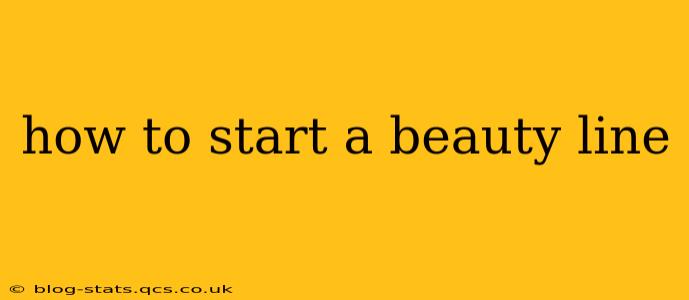Launching your own beauty line is a dream for many, fueled by passion for cosmetics and a vision of creating unique, high-quality products. However, transforming that dream into reality requires careful planning, strategic execution, and a healthy dose of entrepreneurial grit. This comprehensive guide breaks down the essential steps, answering common questions along the way.
1. Develop Your Brand Identity and Business Plan:
Before diving into product formulation, you need a solid foundation. This involves defining your brand's unique selling proposition (USP), target audience, and overall aesthetic. What makes your beauty line different? Are you focusing on natural ingredients, sustainable practices, a specific skin type, or a niche market segment? Your brand story, values, and mission statement should all align with your chosen niche.
A comprehensive business plan is crucial for securing funding and guiding your decisions. It should include market research, competitor analysis, financial projections, marketing strategies, and a detailed operational plan.
2. Product Development and Formulation:
This is where the magic happens! Consider starting with a smaller product line (1-3 items) to manage costs and resources effectively. You have several options for product development:
- DIY Formulation: If you have experience in cosmetic chemistry, you can formulate your products yourself. However, this requires significant knowledge and adherence to strict safety regulations.
- Contract Manufacturing: This is a popular choice for startups. You outsource the manufacturing process to a contract manufacturer, who handles the formulation, production, and packaging. This option saves time and resources, especially for those without manufacturing facilities.
- Private Label: This involves purchasing pre-made products and branding them with your label. It's the quickest option but offers less control over the formulation and ingredients.
Regardless of your chosen method, thorough testing is essential. This includes stability testing (shelf life), safety testing (patch testing, etc.), and efficacy testing (performance claims).
What regulations do I need to comply with for my beauty line?
Navigating regulations is a critical step. You must comply with all relevant laws and regulations regarding cosmetic ingredients, labeling, safety, and packaging in your target markets. Research the specific requirements in your region and consider consulting with a regulatory expert to ensure compliance. Ignoring regulations can lead to significant legal issues and damage your brand reputation.
How much does it cost to start a beauty line?
The startup costs vary significantly depending on factors like product complexity, manufacturing methods, marketing strategies, and initial inventory size. You can expect to spend thousands of dollars on formulation, manufacturing, packaging, labeling, legal compliance, and marketing. Create a detailed budget to ensure you have sufficient capital to cover all expenses.
What are some key ingredients to consider for my beauty line?
Ingredient selection depends on your brand's focus and target audience. Consider factors like sustainability, efficacy, consumer preferences, and any potential allergies or sensitivities. Research trending ingredients and ensure the ingredients align with your brand values.
3. Sourcing and Packaging:
Secure reliable suppliers for your ingredients and packaging materials. Negotiate favorable pricing and ensure timely delivery. Packaging plays a crucial role in brand presentation and product protection. Choose sustainable and aesthetically pleasing packaging options that reflect your brand identity.
4. Marketing and Sales:
Develop a comprehensive marketing strategy to reach your target audience. This may include social media marketing, influencer collaborations, email marketing, paid advertising, public relations, and collaborations with retailers or distributors. Building a strong online presence is vital, including a professional website and engaging social media profiles.
5. Legal and Business Structure:
Choose a suitable legal business structure (sole proprietorship, LLC, etc.) and register your business name and trademarks. Secure necessary licenses and permits. Consult with legal and financial professionals to ensure compliance and manage your business effectively.
Starting a beauty line requires dedication, perseverance, and a keen understanding of the industry. By following these steps and diligently addressing potential challenges, you can increase your chances of creating a thriving and successful beauty brand.
